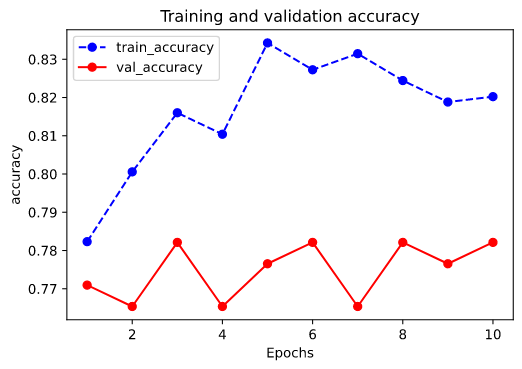5-2 特征列feature_column——eat_tensorflow2_in_30_days
5-2 特征列feature_column
特征列 通常用于对结构化数据实施特征工程时候使用,图像或者文本数据一般不会用到特征列
特征列用法概述#
使用特征列可以将类别特征转换为one-hot编码特征,将连续特征构建分桶特征,以及对多个特征生成交叉特征等等。
要创建特征列,请调用 tf.feature_column 模块的函数。该模块中常用的九个函数如下图所示,所有九个函数都会返回一个 Categorical-Column 或一个 Dense-Column 对象,但却不会返回 bucketized_column,后者继承自这两个类。
注意:所有的Catogorical Column类型最终都要通过indicator_column转换成Dense Column类型才能传入模型!
- numeric_column 数值列,最常用。
- bucketized_column 分桶列,由数值列生成,可以由一个数值列出多个特征,one-hot编码。
- categorical_column_with_identity 分类标识列,one-hot编码,相当于分桶列每个桶为1个整数的情况。
- categorical_column_with_vocabulary_list 分类词汇列,one-hot编码,由list指定词典。
- categorical_column_with_vocabulary_file 分类词汇列,由文件file指定词典。
- categorical_column_with_hash_bucket 哈希列,整数或词典较大时采用。
- indicator_column 指标列,由Categorical Column生成,one-hot编码
- embedding_column 嵌入列,由Categorical Column生成,嵌入矢量分布参数需要学习。嵌入矢量维数建议取类别数量的 4 次方根。
- crossed_column 交叉列,可以由除categorical_column_with_hash_bucket的任意分类列构成。
特征列使用范例#
import datetime
import numpy as np
import pandas as pd
import matplotlib.pyplot as plt
import tensorflow as tf
from tensorflow.keras import layers, models
# 打印日志
def printlog(info):
nowtime = datetime.datetime.now().strftime('%Y-%m-%d %H:%M:%S')
print('\n' + '=========='*8 + '%s' % nowtime)
print(info + '...\n\n')
# 一、构建数据管道
printlog('step1: prepare dataset...')
dftrain_raw = pd.read_csv('./data/titanic/train.csv')
dftest_raw = pd.read_csv('./data/titanic/test.csv')
df_raw = pd.concat((dftrain_raw, dftest_raw))
def prepare_dfdata(df_raw):
dfdata = df_raw.copy()
dfdata.columns = [x.lower() for x in dfdata.columns]
dfdata = dfdata.rename(columns={'survived': 'label'})
dfdata = dfdata.drop(['passengerid', 'name'], axis=1)
for col, dtype in dict(dfdata.dtypes).items():
# 判断是否包含缺失值
if dfdata[col].hasnans:
# 添加标识是否缺失列
dfdata[col + '_nan'] = pd.isna(dfdata[col]).astype('int32')
# 填充
if dtype not in [np.object, np.str, np.unicode]:
dfdata[col].fillna(dfdata[col].mean(), inplace=True)
else:
dfdata[col].fillna('', inplace=True)
return dfdata
dfdata = prepare_dfdata(df_raw)
dftrain = dfdata.iloc[0:len(dftrain_raw), :]
dftest = dfdata.iloc[len(dftrain_raw):, :]
# 从DataFrame导入数据
def df_to_dataset(df, shuffle=True, batch_size=32):
dfdata = df.copy()
if 'label' not in dfdata.columns:
ds = tf.data.Dataset.from_tensor_slices(dfdata.to_dict(orient='list'))
else:
labels = dfdata.pop('label')
ds = tf.data.Dataset.from_tensor_slices((dfdata.to_dict(orient='list'), labels))
if shuffle:
ds = ds.shuffle(buffer_size=len(dfdata))
ds = ds.batch(batch_size)
return ds
ds_train = df_to_dataset(dftrain)
ds_test = df_to_dataset(dftest)
"""
================================================================================2022-06-26 14:43:16
step1: prepare dataset......
"""
# 二、定义特征列
printlog('step2: make feature columns...')
feature_columns = []
# 数值列
for col in ['age', 'fare', 'parch', 'sibsp'] + [c for c in dfdata.columns if c.endswith('_nan')]:
feature_columns.append(tf.feature_column.numeric_column(col))
# 分桶列
age = tf.feature_column.numeric_column('age')
age_buckets = tf.feature_column.bucketized_column(age, boundaries=[18, 25, 30, 40, 45, 50, 55, 60, 65])
feature_columns.append(age_buckets)
# 类别列
# 注意:所有的Categorical Column类型最终都要通过indicator_column转换成Dense Column类型才能传入模型
sex = tf.feature_column.indicator_column(
tf.feature_column.categorical_column_with_vocabulary_list(
key='sex',
vocabulary_list=['male', 'female']
)
)
feature_columns.append(sex)
pclass = tf.feature_column.indicator_column(
tf.feature_column.categorical_column_with_vocabulary_list(
key='pclass', vocabulary_list=[1, 2, 3]
)
)
feature_columns.append(pclass)
ticket = tf.feature_column.indicator_column(
tf.feature_column.categorical_column_with_hash_bucket('ticket', 3) # 桶个数为3
)
feature_columns.append(ticket)
embarked = tf.feature_column.indicator_column(
tf.feature_column.categorical_column_with_vocabulary_list(
key='embarked',
vocabulary_list=['S', 'C', 'B']
)
)
feature_columns.append(embarked)
# 浅入列
cabin = tf.feature_column.embedding_column(
tf.feature_column.categorical_column_with_hash_bucket('cabin', 32),
2
)
feature_columns.append(cabin)
# 交叉列
pclass_cate = tf.feature_column.categorical_column_with_vocabulary_list(
key='pclass',
vocabulary_list=[1, 2, 3]
)
crossed_feature = tf.feature_column.indicator_column(
tf.feature_column.crossed_column([age_buckets, pclass_cate], hash_bucket_size=15)
)
feature_columns.append(crossed_feature)
"""
================================================================================2022-06-26 14:43:19
step2: make feature columns......
"""
# 定义模型
printlog('step3: define model...')
tf.keras.backend.clear_session()
model = tf.keras.Sequential([
layers.DenseFeatures(feature_columns), # 将特征列放入到tf.keras.layers.DenseFeatures中
layers.Dense(64, activation='relu'),
layers.Dense(64, activation='relu'),
layers.Dense(1, activation='sigmoid')
])
"""
================================================================================2022-06-26 14:43:21
step3: define model......
"""
# 四、训练模型
printlog('step4: train model...')
model.compile(
optimizer='adam',
loss='binary_crossentropy',
metrics=['accuracy']
)
history = model.fit(ds_train, validation_data=ds_test, epochs=10)
"""
================================================================================2022-06-26 14:50:42
step4: train model......
Epoch 1/10
WARNING:tensorflow:Layers in a Sequential model should only have a single input tensor, but we receive a <class 'dict'> input: {'pclass': <tf.Tensor 'ExpandDims_8:0' shape=(None, 1) dtype=int32>, 'sex': <tf.Tensor 'ExpandDims_9:0' shape=(None, 1) dtype=string>, 'age': <tf.Tensor 'ExpandDims:0' shape=(None, 1) dtype=float32>, 'sibsp': <tf.Tensor 'ExpandDims_10:0' shape=(None, 1) dtype=int32>, 'parch': <tf.Tensor 'ExpandDims_7:0' shape=(None, 1) dtype=int32>, 'ticket': <tf.Tensor 'ExpandDims_11:0' shape=(None, 1) dtype=string>, 'fare': <tf.Tensor 'ExpandDims_6:0' shape=(None, 1) dtype=float32>, 'cabin': <tf.Tensor 'ExpandDims_2:0' shape=(None, 1) dtype=string>, 'embarked': <tf.Tensor 'ExpandDims_4:0' shape=(None, 1) dtype=string>, 'age_nan': <tf.Tensor 'ExpandDims_1:0' shape=(None, 1) dtype=int32>, 'cabin_nan': <tf.Tensor 'ExpandDims_3:0' shape=(None, 1) dtype=int32>, 'embarked_nan': <tf.Tensor 'ExpandDims_5:0' shape=(None, 1) dtype=int32>}
Consider rewriting this model with the Functional API.
WARNING:tensorflow:Layers in a Sequential model should only have a single input tensor, but we receive a <class 'dict'> input: {'pclass': <tf.Tensor 'ExpandDims_8:0' shape=(None, 1) dtype=int32>, 'sex': <tf.Tensor 'ExpandDims_9:0' shape=(None, 1) dtype=string>, 'age': <tf.Tensor 'ExpandDims:0' shape=(None, 1) dtype=float32>, 'sibsp': <tf.Tensor 'ExpandDims_10:0' shape=(None, 1) dtype=int32>, 'parch': <tf.Tensor 'ExpandDims_7:0' shape=(None, 1) dtype=int32>, 'ticket': <tf.Tensor 'ExpandDims_11:0' shape=(None, 1) dtype=string>, 'fare': <tf.Tensor 'ExpandDims_6:0' shape=(None, 1) dtype=float32>, 'cabin': <tf.Tensor 'ExpandDims_2:0' shape=(None, 1) dtype=string>, 'embarked': <tf.Tensor 'ExpandDims_4:0' shape=(None, 1) dtype=string>, 'age_nan': <tf.Tensor 'ExpandDims_1:0' shape=(None, 1) dtype=int32>, 'cabin_nan': <tf.Tensor 'ExpandDims_3:0' shape=(None, 1) dtype=int32>, 'embarked_nan': <tf.Tensor 'ExpandDims_5:0' shape=(None, 1) dtype=int32>}
Consider rewriting this model with the Functional API.
18/23 [======================>.......] - ETA: 0s - loss: 0.5058 - accuracy: 0.7882WARNING:tensorflow:Layers in a Sequential model should only have a single input tensor, but we receive a <class 'dict'> input: {'pclass': <tf.Tensor 'ExpandDims_8:0' shape=(None, 1) dtype=int32>, 'sex': <tf.Tensor 'ExpandDims_9:0' shape=(None, 1) dtype=string>, 'age': <tf.Tensor 'ExpandDims:0' shape=(None, 1) dtype=float32>, 'sibsp': <tf.Tensor 'ExpandDims_10:0' shape=(None, 1) dtype=int32>, 'parch': <tf.Tensor 'ExpandDims_7:0' shape=(None, 1) dtype=int32>, 'ticket': <tf.Tensor 'ExpandDims_11:0' shape=(None, 1) dtype=string>, 'fare': <tf.Tensor 'ExpandDims_6:0' shape=(None, 1) dtype=float32>, 'cabin': <tf.Tensor 'ExpandDims_2:0' shape=(None, 1) dtype=string>, 'embarked': <tf.Tensor 'ExpandDims_4:0' shape=(None, 1) dtype=string>, 'age_nan': <tf.Tensor 'ExpandDims_1:0' shape=(None, 1) dtype=int32>, 'cabin_nan': <tf.Tensor 'ExpandDims_3:0' shape=(None, 1) dtype=int32>, 'embarked_nan': <tf.Tensor 'ExpandDims_5:0' shape=(None, 1) dtype=int32>}
Consider rewriting this model with the Functional API.
23/23 [==============================] - 1s 10ms/step - loss: 0.5035 - accuracy: 0.7823 - val_loss: 0.4723 - val_accuracy: 0.7709
Epoch 2/10
23/23 [==============================] - 0s 7ms/step - loss: 0.4636 - accuracy: 0.8006 - val_loss: 0.4668 - val_accuracy: 0.7654
Epoch 3/10
23/23 [==============================] - 0s 10ms/step - loss: 0.4410 - accuracy: 0.8160 - val_loss: 0.4457 - val_accuracy: 0.7821
Epoch 4/10
23/23 [==============================] - 0s 11ms/step - loss: 0.4418 - accuracy: 0.8104 - val_loss: 0.4493 - val_accuracy: 0.7654
Epoch 5/10
23/23 [==============================] - 0s 12ms/step - loss: 0.4266 - accuracy: 0.8343 - val_loss: 0.4597 - val_accuracy: 0.7765
Epoch 6/10
23/23 [==============================] - 0s 12ms/step - loss: 0.4232 - accuracy: 0.8272 - val_loss: 0.4441 - val_accuracy: 0.7821
Epoch 7/10
23/23 [==============================] - 0s 10ms/step - loss: 0.4201 - accuracy: 0.8315 - val_loss: 0.4567 - val_accuracy: 0.7654
Epoch 8/10
23/23 [==============================] - 0s 12ms/step - loss: 0.4178 - accuracy: 0.8244 - val_loss: 0.4493 - val_accuracy: 0.7821
Epoch 9/10
23/23 [==============================] - 0s 8ms/step - loss: 0.4201 - accuracy: 0.8188 - val_loss: 0.4399 - val_accuracy: 0.7765
Epoch 10/10
23/23 [==============================] - 0s 10ms/step - loss: 0.4190 - accuracy: 0.8202 - val_loss: 0.4649 - val_accuracy: 0.7821
"""
# 五、评估模型
printlog('step5: eval model...')
model.summary()
%matplotlib inline
%config InlineBackend.figure_format='svg'
import matplotlib.pyplot as plt
def plot_metric(history, metric):
train_metrics = history.history[metric]
val_metrics = history.history['val_' + metric]
epochs = range(1, len(train_metrics) + 1)
plt.plot(epochs, train_metrics, 'bo--')
plt.plot(epochs, val_metrics, 'ro-')
plt.title('Training and validation ' + metric)
plt.xlabel('Epochs')
plt.ylabel(metric)
plt.legend(['train_'+metric, 'val_'+metric])
plt.show()
plot_metric(history, 'accuracy')
"""
================================================================================2022-06-26 14:57:28
step5: eval model......
Model: "sequential"
_________________________________________________________________
Layer (type) Output Shape Param #
=================================================================
dense_features (DenseFeature multiple 64
_________________________________________________________________
dense (Dense) multiple 2944
_________________________________________________________________
dense_1 (Dense) multiple 4160
_________________________________________________________________
dense_2 (Dense) multiple 65
=================================================================
Total params: 7,233
Trainable params: 7,233
Non-trainable params: 0
_________________________________________________________________
"""
作者:lotuslaw
出处:https://www.cnblogs.com/lotuslaw/p/16413547.html
版权:本作品采用「署名-非商业性使用-相同方式共享 4.0 国际」许可协议进行许可。






【推荐】国内首个AI IDE,深度理解中文开发场景,立即下载体验Trae
【推荐】编程新体验,更懂你的AI,立即体验豆包MarsCode编程助手
【推荐】抖音旗下AI助手豆包,你的智能百科全书,全免费不限次数
【推荐】轻量又高性能的 SSH 工具 IShell:AI 加持,快人一步
· 阿里最新开源QwQ-32B,效果媲美deepseek-r1满血版,部署成本又又又降低了!
· 开源Multi-agent AI智能体框架aevatar.ai,欢迎大家贡献代码
· Manus重磅发布:全球首款通用AI代理技术深度解析与实战指南
· 被坑几百块钱后,我竟然真的恢复了删除的微信聊天记录!
· 没有Manus邀请码?试试免邀请码的MGX或者开源的OpenManus吧